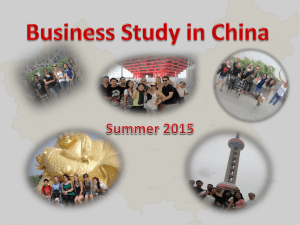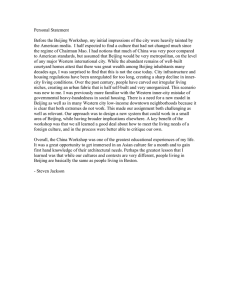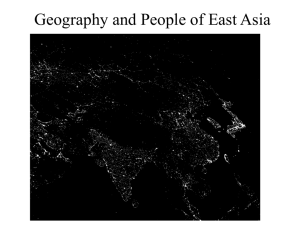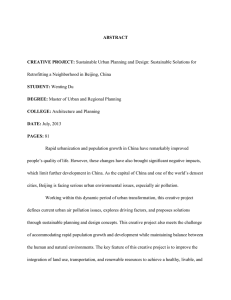North China Plain andn Beijing
advertisement
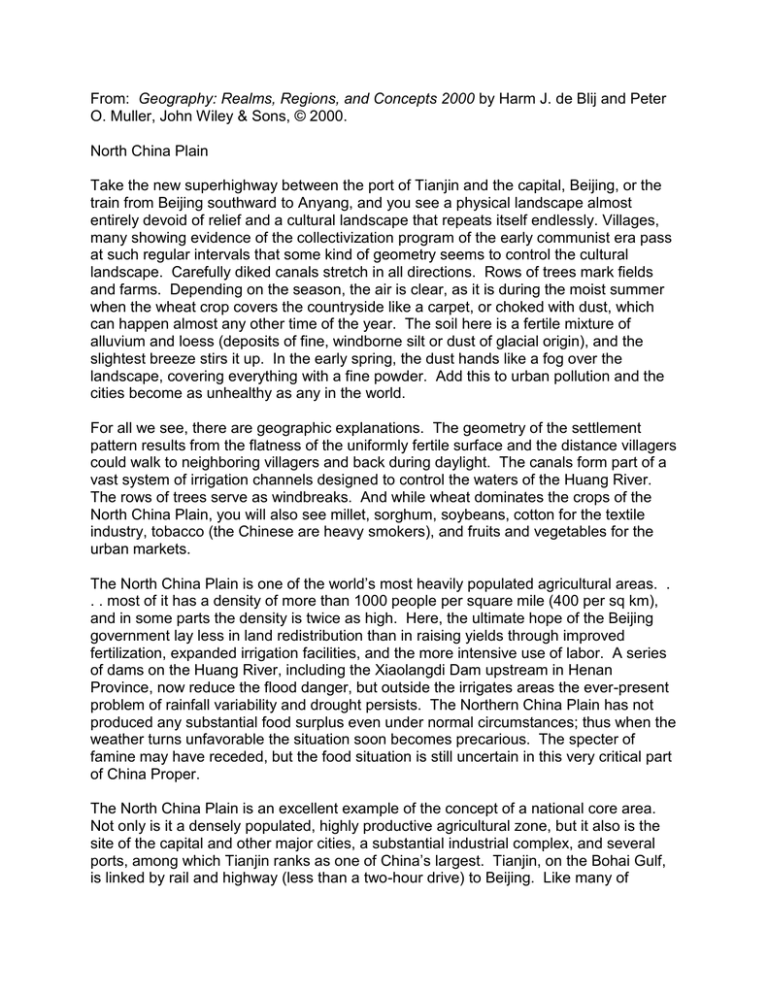
From: Geography: Realms, Regions, and Concepts 2000 by Harm J. de Blij and Peter O. Muller, John Wiley & Sons, © 2000. North China Plain Take the new superhighway between the port of Tianjin and the capital, Beijing, or the train from Beijing southward to Anyang, and you see a physical landscape almost entirely devoid of relief and a cultural landscape that repeats itself endlessly. Villages, many showing evidence of the collectivization program of the early communist era pass at such regular intervals that some kind of geometry seems to control the cultural landscape. Carefully diked canals stretch in all directions. Rows of trees mark fields and farms. Depending on the season, the air is clear, as it is during the moist summer when the wheat crop covers the countryside like a carpet, or choked with dust, which can happen almost any other time of the year. The soil here is a fertile mixture of alluvium and loess (deposits of fine, windborne silt or dust of glacial origin), and the slightest breeze stirs it up. In the early spring, the dust hands like a fog over the landscape, covering everything with a fine powder. Add this to urban pollution and the cities become as unhealthy as any in the world. For all we see, there are geographic explanations. The geometry of the settlement pattern results from the flatness of the uniformly fertile surface and the distance villagers could walk to neighboring villagers and back during daylight. The canals form part of a vast system of irrigation channels designed to control the waters of the Huang River. The rows of trees serve as windbreaks. And while wheat dominates the crops of the North China Plain, you will also see millet, sorghum, soybeans, cotton for the textile industry, tobacco (the Chinese are heavy smokers), and fruits and vegetables for the urban markets. The North China Plain is one of the world’s most heavily populated agricultural areas. . . . most of it has a density of more than 1000 people per square mile (400 per sq km), and in some parts the density is twice as high. Here, the ultimate hope of the Beijing government lay less in land redistribution than in raising yields through improved fertilization, expanded irrigation facilities, and the more intensive use of labor. A series of dams on the Huang River, including the Xiaolangdi Dam upstream in Henan Province, now reduce the flood danger, but outside the irrigates areas the ever-present problem of rainfall variability and drought persists. The Northern China Plain has not produced any substantial food surplus even under normal circumstances; thus when the weather turns unfavorable the situation soon becomes precarious. The specter of famine may have receded, but the food situation is still uncertain in this very critical part of China Proper. The North China Plain is an excellent example of the concept of a national core area. Not only is it a densely populated, highly productive agricultural zone, but it also is the site of the capital and other major cities, a substantial industrial complex, and several ports, among which Tianjin ranks as one of China’s largest. Tianjin, on the Bohai Gulf, is linked by rail and highway (less than a two-hour drive) to Beijing. Like many of China’s harbors, that of Tianjin’s river port is not particularly good; but Tianjin is well situated to serve not only the northern sector of the North China Plain and the capital, but also the Upper Huang Basin and Inner Mongolia beyond. Tianjin, again like several other Chinese ports, had its modern start as a treaty port, but the city’s major growth awaited communist rule. For decades it was a center for light industry and a floodprone harbor, but after 1949 the communists constructed a new artificial port and flood canals. They also chose Tianjin as a site for major industrial development and made large investments in the chemical industry (in which Tianjin still leads China), iron and steel production, heavy machine manufacturing, and textiles. Today, with a population of 12.4 million, Tianjin is China’s fourth largest metropolises and the center of one of its leading industrial complexes. Northeast of Tianjin lies the smaller city of Tangshan. In 1976, a devastating earthquake, with its epicenter between Tangshan and Tianjin, killed and estimated 750,000 people, the worst natural disaster of the twentieth century. So inept was the government’s relief efforts in nearby Beijing that the widespread resentment it provoked may have helped end the Maoist period of communist rule in China. Beijing, unlike Tianjin, is China’s political, cultural, and educational center. Its industrial development has not matched Tianjin’s. The communist administration did, however, great6ly expand the municipal area of Beijing, which . . . is not controlled by the province of Hebei but is directly under the central government’s authority. In one direction, Beijing was enlarged all the way to the Great Wall—30 miles (50 km) to the north—so that the “urban” area includes hundreds of thousands of farmers. Not surprisingly, this has circumscribed an enormous total population, enough to rank Beihjing, with its 14.2 million inhabitants, among the world’s larger megacities. Beijing Beijing (14.2 million), capital of China, lies at the northern apex of the roughly triangular North China Plain, just 100 miles (160 km) from its port, Tianjin, on the Bohai Gulf. Urban sprawl has reached the hills and mountains that bound the Plain to the north, a defensive barrier fortified by the builders of the Great Wall. You can reach the Great Wall from central Beijing by road in about an hour. Although settlement on the site of Beijing began thousands of years ago, the city’s rise to national prominence began during the Mongol (Yuan) Dynasty, more than seven centuries ago. The Mongols, preferring a capital close to their historic heartland, endowed the city with walls and palaces. Following the Mongols, later rulers at times moved their capital southward, but the government always returned to Beijing. From the third Ming emperor onward, Beijing was China’s focus; it was ideally situated for the Manchus when they took over in 1644. During the twentieth century, China’s Nationalists again chose a southern capital, but when the communists prevailed in 1949 they reestablished Beijing as their (and China’s) headquarters. Ruthless destruction of historic monuments carried out from the time of the Mongols to the communists (and now during China’s modernization) has diminished, but not destroyed, Beijing’s heritage. From the Forbidden City of the Manchu emperors to the fifteenth-century Temple of Heaven, the capital remains an open-air museum and the cultural focus of China. Successive emperors and aristocrats, moreover, bequeathed the city numerous parks and additional recreational spaces that other cities lack. Today Beijing is being transformed as a result of China’s new economic policies. A forest of high-rises towers above the traditional cityscape, avenues have been widened, and a beltway is being built. A new era dawns in this historic capital. Added Note from Joe: Climatically, Beijing is classified as Dwb according to the Koppen-Geiger classification system, whereas St. Louis is classified as Cfa. The Dwb is more like the climate of Iowa or of Minnesota, except it is drier in the winter than they are (they are classified as Dfa and Dfb – the “f” indicating year-round precipitation). The “w” in Beijing’s climate indicates a dry winter. Beijing has a longer, colder winter than St. Louis and a hot to warm summer which is a little shorter than that of St. Louis. We should be there at the very beginning of Spring (usually March 21 or 22, so we can expect it to be chillier than St. Louis at that time). It may be a good idea to have easily layered clothes to wear because we might have some mild days as well as some frosty ones. I will probably be quite chilly in the morning and might get to be warm in the afternoons on a few days.
